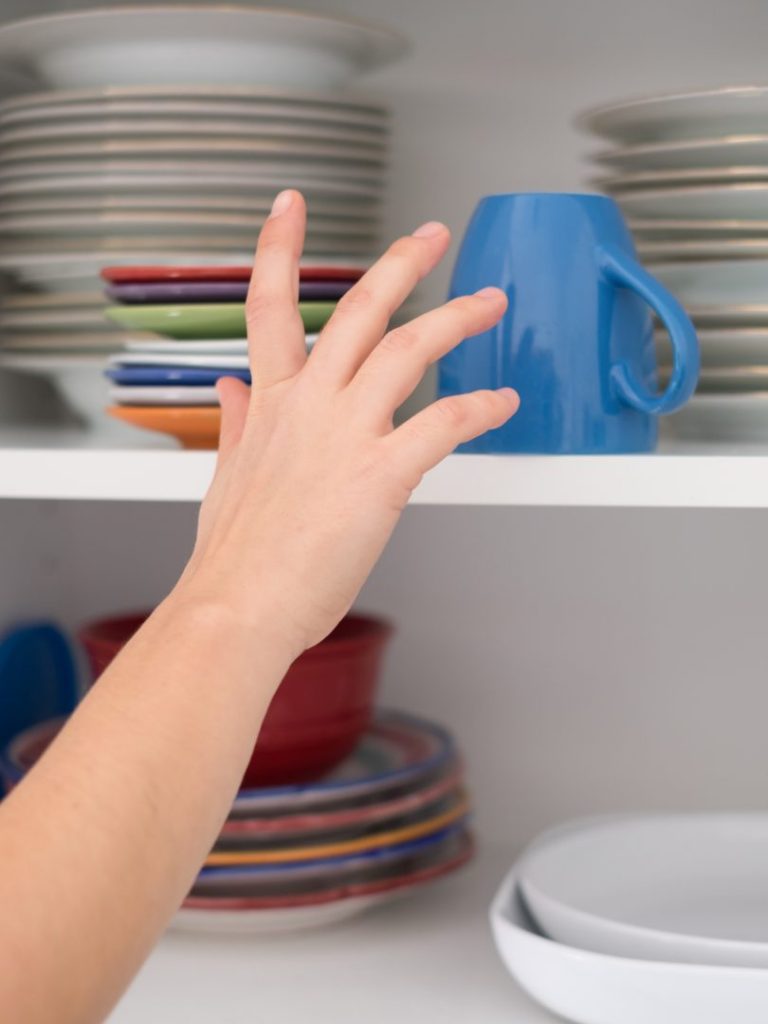
A fully extended hand going for this cup can cause injury to the user and the risk of dropping the item being retrieved – locating shelving too high is a definite design consideration to minimize
The Declaration of Independence and Thomas Jefferson notwithstanding, people are not created equal. We have very different abilities, and those abilities are subject to change throughout our lifetimes. Some of us are more able-bodied than others, and some of us can perform more activities than others. Some of us enjoy better health.
In short, we all are different. Even twin siblings may find their outlooks on life and the way they live to be quite different as they get older. While they share a common bond, as do all siblings, each person develops in their own way based on their life experiences. Even while children and living at home, each person interprets their living environment and their interactions with their parents and others in the home differently. People develop their own tastes and preferences in food, entertainment, colors, hobbies, and favorite topics to discuss and pursue. They seek different personal relationships.
This is why there cannot be a classic aging in place solution devised that applies universally. There just are too many variables and variations. In short, we are all different with different needs and abilities, requiring a multitude of approaches and solutions to address those abilities.
With that in mind, one of the most important types of aging in place solutions, and the one frequently overlooked or unconsidered is the one involving someone’s ability to reach. We are talking about how easy it is for someone to extend their arm and make contact with items in their home that they want to use – the window, a cabinet door, a shelf, the shower controls, the bathroom faucet, the top drawer of the dishwasher, the top drawer of their clothes dresser, and so many other items that seemingly are designed and created for the general population but miss the mark for many people with short arms or a short stature, those people approaching things from a seated position, or those who otherwise do not have the ability to fully extend their arms fully and completely.
There are many reasons why people cannot fully extend their arms, Joint difficulties, range of motion issues, or decreased muscle flexibility can limit someone’s ability to extend their arms in the direction they intend.
Intuitively, when we think of reaching our arms straight out, we think of extending them 180 degrees above our heads and pointing them straight upward. Many people simply cannot do this. Injuries, arthritis, and other limitations can hamper a person’s ability to do this. Limitations in using and freely rotating the shoulder joint can affect this extension as much or more than flexibility in the other joints of the arm – elbow or wrist, for instance.
Therefore, a practical full extension might be only a 50-60 percent extension – meaning that someone might be able to elevate their arms only to a 45-60 degree angle from their body, from a position parallel to the floor, rather than the full upward extension. This has enormous implications for the design and installation of upper cabinets and shelving in kitchens, bathrooms, bedrooms, laundry rooms, closets, and anyplace else in the home where storage is designed and intended.
When people cannot use the cabinets or shelves in their homes (or range hoods) because they cannot reach them effectively – because they are beyond their physical abilities to do so – their homes are ineffective for them. This is unacceptable. People need to be able to use their home and all of the components within them – and use them easily and safely.
Even when they can be reached because someone can touch them with their fingertips, they still are unusable if a person cannot retrieve an object from the shelf or cabinet and hold onto it without dropping it while they move it to where they want to use it. This is a case of all four major aspects of home design – accessibility. comfort, convenience, and safety.
A person must have full access to the items in their home (not just in approaching them but in grasping and controlling them also), the shelving must be at a convenient height that does not strain or inconvenience the users, and there should be no risk of injury from pulling a muscle or overextending oneself to access the height of the shelf or removing something from it that is at a height that makes the object unwieldy.
Reach is typically discussed as it applies to our hands and arms, but it is more than this – it can involve our necks as in turning or lifting our heads to look at or view something, our legs as in stepping or walking (or squatting, kneeling, or standing after bending to retrieve something), or our trunk or torso in twisting or turning to move a certain way or position ourselves differently in the home,
Our requirements for reaching definitely impacts aging in place design solutions.
